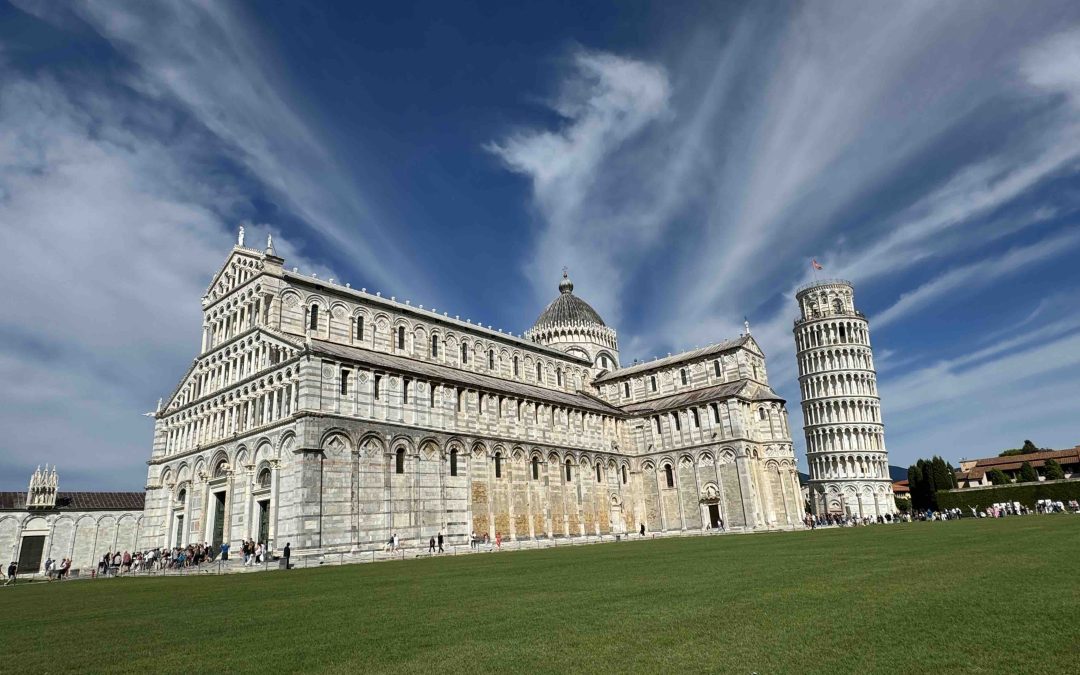This post contains affiliate links.
Is Pisa Italy worth a visit? That depends. If you’re determined to capture that iconic leaning tower of Pisa photo for yourself, you know the one, where you’re tapping the building sideways, than yes, yes it is. If you want to learn some Italian history and view structures of architectural significance and historical artifacts, than yes, by all means plan a visit. But if you’re looking to avoid crowds, or searching for a unique lesser known destination in Italy, you might want to give Pisa a pass.
We arrived in Pisa from Loverno, via the ferry from Bastia to Italy, after a cycling trip in Corsica. Since Pisa was the closest major town to the port of Loverno, where car rentals were reasonably priced for our tour of Tuscany, we had multiple reasons to journey to Pisa Italy.
And truth be told, I wanted one of those leaning tower of Pisa photos for myself.
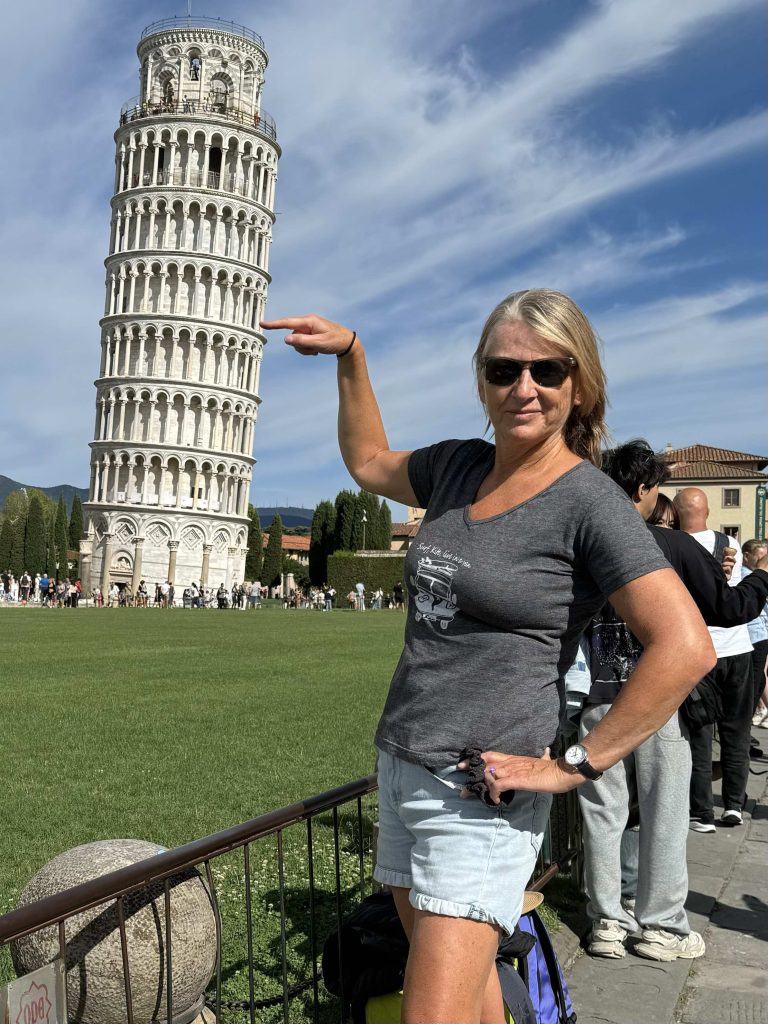
The visit got off on a bad start though, when my husband left my carry bag in the taxi. We were juggling our backpacks and day bags, so the black bag against the black cab seat in the back was missed upon quick exit. At least that’s the story I consoled myself with in an attempt to remediate a couples spat. The bag contained my cell phone charger, a flash drive and battery pack, sunglasses case and our lunch plus wine. Of course we only realized the bag was missing when I went looking for the sandwiches for a picnic on Piazza del Duomo grassy square.
So admittedly our visit to Pisa was a bit tainted out of the gate, but we made the best of it.
A UNESCO World Heritage Site
Pisa’s UNESCO World Heritage Site is one of Italy’s most gorgeous squares. The green grass of the square is a perfect setting for the Pisan-Romanesque gemstones of the Duomo, Camposanto, Bapistry and Campanile (that icon better known as the Leaning Tower). Beware though, only certain parts of the grassy area are accessible for use, as others are signed off limits.
The east side of the square is anchored by the old bishop’s palace, now the Duomo museum. The souvenir stalls are a bit overwhelming when you first arrive. Clinging like barnacles to the square’s south side, you do have to navigate through them to find the entrance which opens into the square.
Basically prepare to immerse yourself in Italian history, and navigate as quickly as possible through the souvenir tourist trap.
While the Leaning Tower might be the main attraction, be sure to check out other historical structures in the square.
Duomo’s San Ranieri Door
In 1180, Bonanno Pisano sculpted the only remaining Romanesque bronze door of Pisa’s cathedral. Gracing it with minimalist biblical scenes and palm trees, the original door is now in the Museo dell ‘Opera.
Duomo Pulpit
Inside the Duomo you’ll find a pulpit, which Nicola Pisano’s son Giovanni carved in 1302-11. The Gothic era style is evident it the interpretation of tumultuous New Testament scenes.
Leaning Tower
Construction of the Leaning Tower bell tower designed in the Pisa-Romanesque style began in 1173. During construction, it started leaning when builders were on the third level. At issue was the 55 meters (180 ft) of marble stacked atop watery sand. Work stopped because of the lean, but started again in 1275 when it was decided to curve the tower back as it rose.
In 1990 to tower was 4.5 meters (15 ft) off vertical, and closed by engineers for safety reasons so it could be stabilized. At the time over 1 million tourists annually were arriving to walk up the tower, and the fear of collapse was real. So they closed the tower and had weights stacked on one side at the base and excavated to try to reverse the lean. It opened again in 2001 but now entry is granted to a limited number of visitors, ticketed at set times. In 2008 engineers determined that the tower should remain stable for another 200 years.
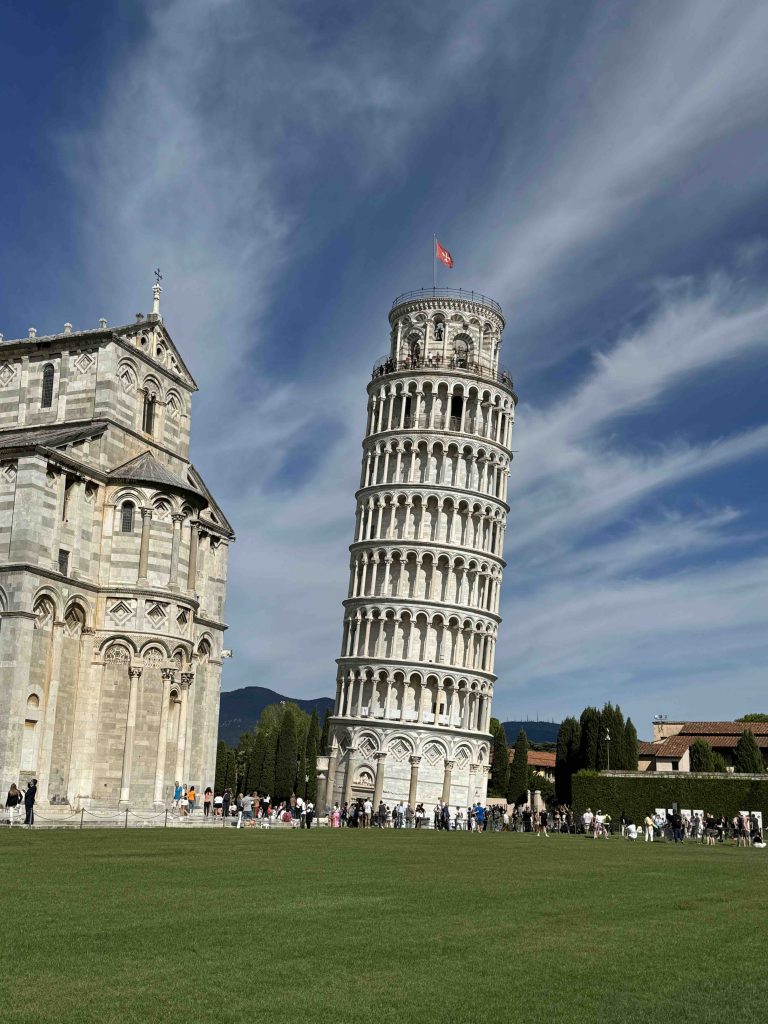
Duomo Façade
The façade is a triumph of blind arcades, stacked open arches and colored marble decorations. Giambologna cast the bronze doors to replace the ones destroyed by fire in 1595.
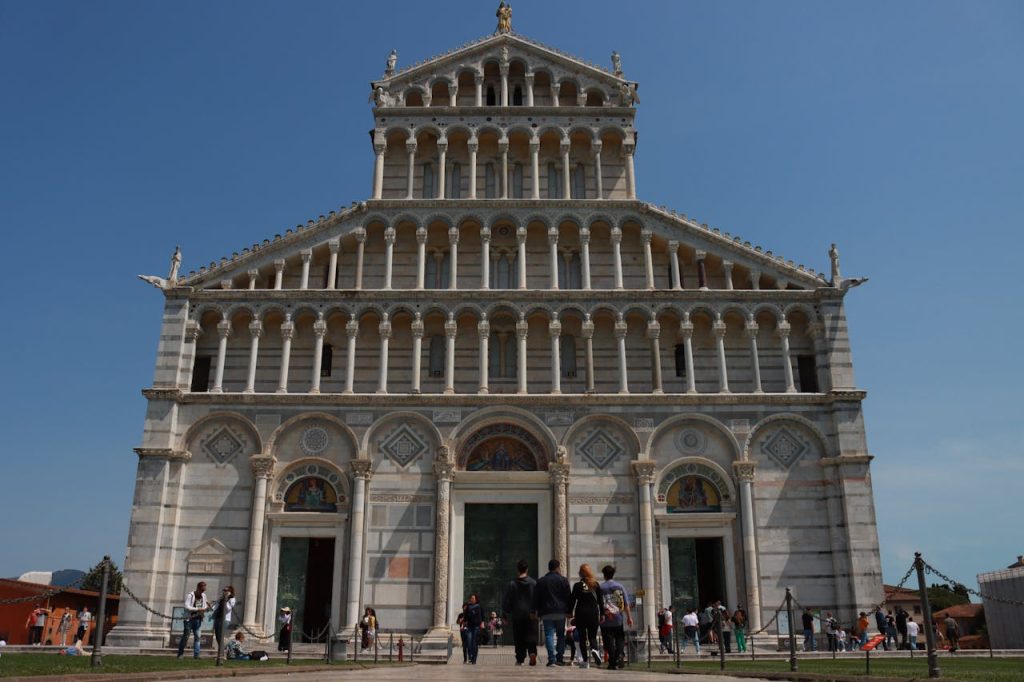
Museo delle Sinopie
Sketches for the lost Camposanto fescoes were discovered by restorers. They reveal insight into the creative process of medieval artists.
Museo dell’Opera del Duomo
The rich collection in this museum includes 11th century Islamic bronze hippogriff (half horse, half griffin)
Baptistry
Italy’s largest Baptistry started out as a Romanesque piece in 1153, but has a Gothic dome.
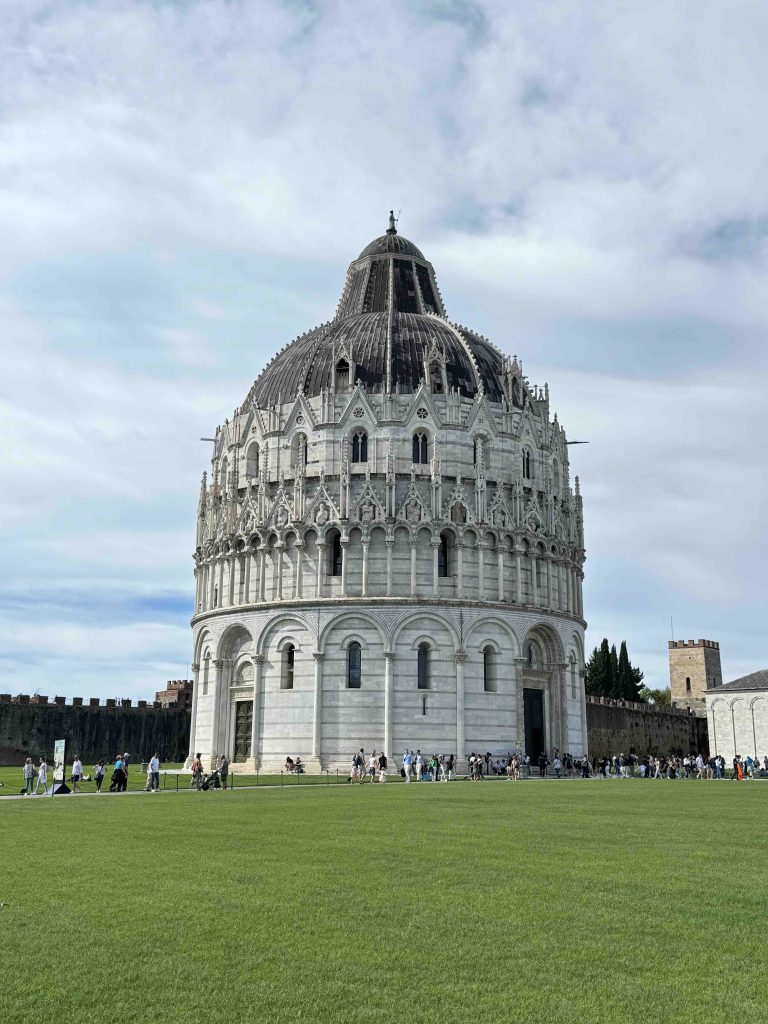
Gothic pulpit
A Gothic pulpit is housed within the acoustically perfect interior of the Baptistry. Nicola Pisano’s Gothic masterpiece (1255-60) depicts several religious scenes based on ancient pagan reliefs.
Camposanto
This former cemetery contains recycled Roman sarcophagi, once featured in frescoes that rival those in the Sistine Chapel. Most of it was destroyed in WWII, but a few sections are preserved in the back room.
Camposanto Triumph of Death Fresco
It’s unfortunate that so much damage was done during WWII bombing throughout Europe, but it’s a story thread touring many locations. The Camposanto Tiumph of Death Fresco is the best of those that survived the bombing. It depicts the scene of Death riding across an apocalyptic landscape. The scene inspired Liszt to compose his Totentanz concerto.
Tickets
Entry tickets for these venues can be purchased as a multi-pass, which includes the tower as part of the cathedral complex, the Pisa Baptistery and Duomo di Pisa. There are several options, but booking the complete + tower combo will allow you to climb the tower and visit all of the sights.
You’re best to book tickets in advance, since arriving on the day, hoping to climb the tower, is likely to end in disappointment. Entry tickets for the tower are also timed, so be sure to plan accordingly and not be late!
Of course if you don’t care to enter any of the buildings, touring the exteriors and enjoying the square is absolutely free. But to truly appreciate some of the rich history, purchasing entry, doing a self-guided tour, or joining an organized tour, will add to the experience.
Book entry tickets and tours HERE for Pisa.
Looking for a place to stay in Pisa?
Should you book a tour or DIY?
That really depends on your travel style, your ability to organize, plan and book in advance, and frankly how much time you have while in Pisa Italy.
More than a photo opp, the Leaning Tower of Pisa and the surrounding square have a rich history which highlights to powerful position Pisa once had in Italy. Tapping into that with the facts, stories and details told by a local guide could enrich your experience, especially if you are a student of art, history or architecture.
What’s the best time to visit Pisa Italy?
While shoulder season is quickly becoming the new prime time with rising temperatures across Europe, springtime – April, May and autumn – Sept, October are definitely less crowded than the summer months of June, July and August. Winter is also an option to encounter few crowds, but the colder weather and possibility of rain will be your trade off.
How long do you need in Pisa Italy?
A full day is ample, and if necessitated by time, and you’re well organized, a half day could certainly do it.
Where should i eat?
The further you are from the Piazza del Duomo, the less touristy things are, and by default, the less expensive your dining experience will be, and the more local authentic food you are apt to find. Check out a café or bar along the Arno River for best local options.
What else is there to see in Pisa Italy?
Because so many people arrive in Pisa to see the Leaning Tower, the area around Piazza del Duomo is where tourists tend to be found. Many are in and out of the city within the day too. That leaves other areas of Pisa with a decidedly local feel.
We took the opportunity to walk from the Piazza del Duomo to the airport to pick up our rental car later in the day, and I can attest to it feeling a whole lot less touristy once you leave the square. The walk took us about 45 minutes, crossing the Arno River bridge along the way.
We walked along the Pisa city walls, which were constructed in the 12th century as a layer of protection for the city. They are now some of the oldest walls in Italy, still fully intact.
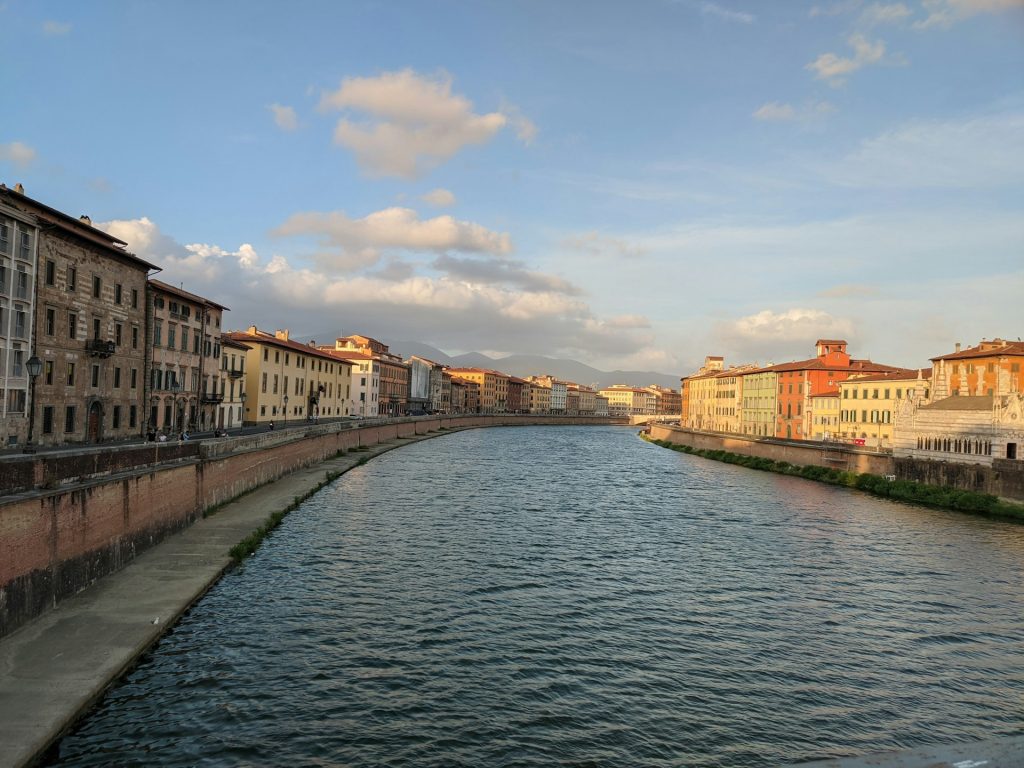
The Arno River, roughly divides the city of Pisa. During the summer there are many bars and cafes open along the river’s banks. The Church of Santa Maria Della Spina is a 13th century church nestled along the river bank, and a site many visiting Pisa for the tower main attraction would miss, if not staying in town for the night or taking time to wander.
The lost bag
For those curious about the bag left in the cab saga, and how our marriage survived while I came to terms with my husband’s mistake, I can assure you girlfriends at home were wondering too, as I vented about the lost items in our group chat.
We were never able to recover the items, despite the bag contained my business card with cell phone and email. I maintained hope of being contacted throughout the day. Uber hadn’t been available from Loverno, so we had grabbed a cab on the street. Otherwise we might have had a way to track the driver down.
I was pretty choked about the loss initially, but like most good travel stories it ended well. We were able to replace the cell charger cord at a gas station after picking up the rental car, and several days later I found a sweet new sunglasses case at an optician in Siena, along with a new daypack at a local sporting goods store there. Both items are superior to what I had before, and every time I close the stylish magnetic leather sunglasses case now, with the most satisfying baritone heavy “thunk”, it brings back fond memories of Italy.
More content from Italy
Saturnia Hot Springs in Italy: How to avoid crowds
Chianti Italy: A Tuscany winery tale
When Language Knows No Barrier to Friendship: An Italian family dinner in Tuscany

